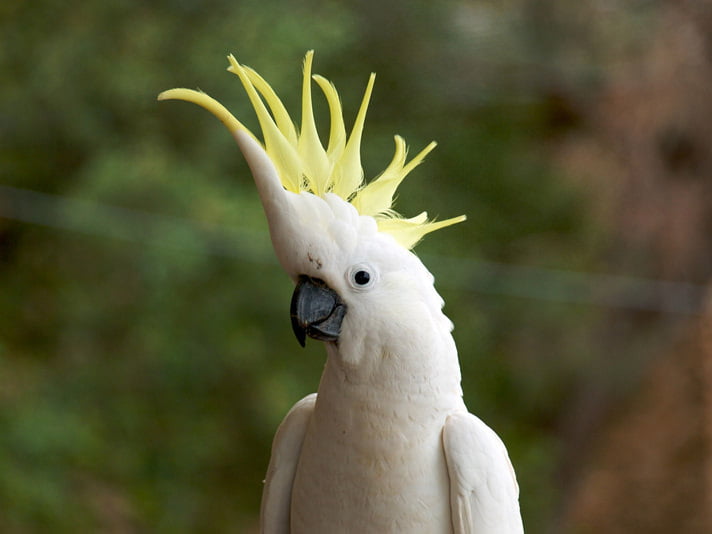Birds are amazing creatures that can make great pets. These animals are categorized as exotic pets and offer tremendous variety. Whereas 177 – 340 breeds of dogs and 43 – 73 breeds of cat are recognized in the world by various organizations, there is only one canine species and one feline species. There are more than 300 species of parrots of which the cockatoo is one. Herein are some steps to ensure a happy and healthy relationship with your pet bird.
1. Learn about cockatoos before deciding to buy one.
Making a realistic assessment about your lifestyle, personality and household situation is key. Educate yourself about caring for a cockatoo and be aware of the potential issues that care may entail. Aviculturist and cockatoo specialist Katy McElroy says, “If you have an idea of what’s going to happen, you can be prepared for these situations. People who buy a cockatoo knowing what they’re getting into…usually do a much better job with the bird, and there aren’t any major surprises.”
2. Find a young cockatoo raised for living with a human flock.
McElroy believes owners who tend to be independent do better with cockatoos which are naturally needy. “So many people buy them because they want this super cuddly teddy bear, but they don’t teach the cockatoo anything else,” she said.
3. Buy the largest cage you can afford.
For the smaller Goffin cockatoo species, McElroy recommends minimum cage dimensions of 24-inches-deep by 36-inches-wide. For the larger cockatoo species like umbrellas and Moluccans, she recommends minimum cage dimensions of 30-inches-deep by 48-inches-wide. Sam Foster is an avian consultant specializing in cockatoo care and behavior. According to Foster, “if you have them in a very large enclosure with lots of ways to exercise, they can take out their frustrations by ripping and shredding and bouncing around inside their cage where they have a lot of room – rather than…trying to resolve the issue when they get out of their cage, and they’re chasing you around the room.”
4. Cockatoos need to feel part of a flock
Place the cage in a high-traffic area of the home where the cockatoo can be a part of daily activity, like the living room. Don’t put your cockatoo in a room alone where it will feel isolated. The exception is a cage only for sleeping at night.
5. Provide a wide variety of high-quality parrot toys.
Cockatoos must learn to amuse themselves when you are not around. That is why you need to show your bird what various toys do by playing with them yourself to see if your bird will follow your lead. According to bird behavior consultant Michelle Karras, “Cockatoos love to play with their toys if they know how to do so.”
6. Feed your cockatoo a proper diet.
A fortified pelleted-base diet supplemented with cooked or raw vegetables, fruit, seeds and nuts is recommended by most veterinarians. Exercise caution relative to feeding foods high in sugar or carbohydrates. “Diet has a huge impact on behavior,” says Foster. “If you’re feeding a cockatoo a diet that’s high in carbohydrates or sugar…the bird is probably going to be a lot more vocal and hyperactive…”
7. Allow your cockatoo 15 to 20 minutes of rigorous exercise daily
Acclimate your bird to wearing a harness and leash so you can take it outside for walks. Yes, you read that correctly. Also, play a game of fetch and catch with your cockatoo with a soft, lightweight object like a Koosh ball or stuffed toy. Just like dogs, in which daily exercise makes them happier, healthier and more manageable, so too does daily exercise for cockatoos.
8. Permit scream time.
“Cockatoos have a real need to be raucous,” says Karras. She suggests teaching your bird to scream during the same time period everyday. “Your cockatoo learns that it’s OK to make a noise at a certain time, [so] he’s able to get rid of excess energy, and you have control of the screaming.” To teach your cockatoo, wait for the bird to start vocalizing during the designated time range. “Before the bird is actually in a full-fledged scream and is just being vocal, put on some music that you know the bird likes, and literally blast it and get the bird going. The bird will start dancing and showing off and then start to scream,” explains Karras. “Play a song two or three times in a row, and then switch over to softer music and then lower it and then start talking the bird down and telling it that now it’s going to be quiet time and to settle down.” Offer fresh food afterward.
9. Impose boundaries.
Create rules and enforce them consistently. “You have to have enough of a spine to be willing to take a cuddly Moluccan cockatoo off your lap and put it on a T-stand, and make it spend some time on its own away from you,” says avian veterinarian Brian Speer DMV, co-author of Birds for Dummies (IDG Books, 1999).
This article was adapted from a story written and featured by Petcha titled “9 Steps To Avoid ‘Unwanted Cockatoo Syndrome’.”

